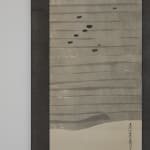Tosa Mitsubumi (1812–1879)
Snow at Night
Ink on paper, hanging scroll
With box authentication by Isaka Chojitsuan
Seals: To, Mitsubumi
112 x 30.5 cm
190 x 42.7 cm (overall)
With box authentication by Isaka Chojitsuan
Seals: To, Mitsubumi
112 x 30.5 cm
190 x 42.7 cm (overall)
Further images
Provenance
Collection of Isaka Chojitsuan
Isaka Chojitsuan (1892–1973), a Meiji period entrepreneur and a tea master, inscribed Snow at Night on the lid of the box. It was in 1921 that the present hanging scroll was remounted. Never is it certain whether or not Chojitsuan followed the title on the prior box; nonetheless, his inscription to this painting is genuinely proper. While compared with Tosa Mitsubumi’s fusuma paintings in the manner of the orthodox Yamato-e, the present work, merely consisting of snow and the ground, is rather novel. A similar composition could be dated back to Maruyama Okyo, and also seen in Mitsubumi’s contemporary Nakajima Raisho’s Setsu-getsu-ka, a typical subject comprising a moon in the center, cherry blossoms and a snow scene at both sides as a triptych. Considering the subject and the position of the seal in comparison with the above-mentioned works by Okyo and Raisho, the present work is likely to be the right piece of Setsu-getsu-ka triptych. Snowflakes in works by Okyo and Raisho are treated unpainted within areas of thinly applied ink. Such is also found in paintings of snowy night motif, such as Buson’s Snowclad Houses in the Night. Examples of snowflakes painted in ink as in this work are rarely seen. Darkened cherry blossoms are found in some night scene paintings by Nagasawa Rosetsu and Suzuki Kiitsu. In Rosetsu’s case, he painted the silhouette of cherry blossoms in black against the moonlight. Similarly, the snowflakes being darkened here might result from the moon shining behind. It is fair to believe that this work is the right piece of the Setsu-getsu-ka, the central piece must be the moon, and the cherry blossoms on the left have been painted black so as to keep a consistency with the ink snowflakes.
Tosa Mitsubumi (painter; 1812–1879)
Also known as Nobumaru, Shihei, Kansui.
Kyoto-born late Edo to early Meiji-period painter. The 22nd generation head master of Tosa school. The second son of Tosa Mitsuzane. Adopted son of Tosa Mitsutomi. Appointed Edokoro azukari (head of the Imperial Painting Bureau). Participated in the rebuilding of Kyoto imperial palace in Ansei era (1854–1860) and other imperial orders, and was appointed Bizennokami with junior fourth rank. Joined Higashiyama shunju gakai. After its disbandment, co-founded Joun-sha with Nakajima Raisho and Shiokawa Bunrin. Recognized as the leading artist of the last of Tosa school.
Tosa Mitsubumi (painter; 1812–1879)
Also known as Nobumaru, Shihei, Kansui.
Kyoto-born late Edo to early Meiji-period painter. The 22nd generation head master of Tosa school. The second son of Tosa Mitsuzane. Adopted son of Tosa Mitsutomi. Appointed Edokoro azukari (head of the Imperial Painting Bureau). Participated in the rebuilding of Kyoto imperial palace in Ansei era (1854–1860) and other imperial orders, and was appointed Bizennokami with junior fourth rank. Joined Higashiyama shunju gakai. After its disbandment, co-founded Joun-sha with Nakajima Raisho and Shiokawa Bunrin. Recognized as the leading artist of the last of Tosa school.









